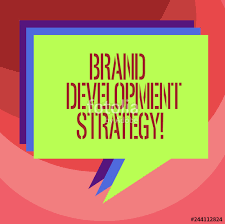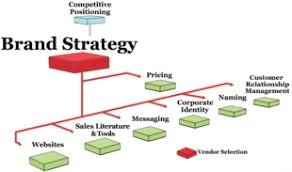Brand Development Strategy
Hi there again

Courtesy of Google
To simplify things, a Brand Strategy is a document that contains exactly what your brand is about. Brand strategy is the process of creating and strengthening your professional services brand. A well defined and developed brand strategy will give great details about every aspect of your business. Your brand strategy should contain beliefs, visions, goals, and plans, that can all be achieved as your brand grows and develops.
Now don’t get it wrong, your brand is not; Your logo, brand name, website, or your product. These form part of your brand identity, which should reflect in your brand strategy.
Amazon Founder and CEO, Jeff Bezos describes it simply: “Your brand is what other people say about you when you’re not in the room.”
If you are to be in control of the above and guide it, you have to develop a brand strategy that keeps your business and brand running in the right direction always. Just like every other thing in life, you can make research and start developing your brand strategy by asking the right questions in the right places.

Courtesy of Google
The brand strategy process can be divided into three phases.
- The first phase is getting your brand strategy right and then you align it with your business objectives.
- Second is developing all the tools you will need to communicate the brand, such as your logo, tagline and website and the likes
- And Last but not the least, there is the phase of strengthening your newly developed or updated brand.
Listed below are some steps to make coming up with your brand development strategy easy. (Courtesy of Hingemarketing)

Courtesy of Google
Some Steps In Brand Development Strategy You Should Know
1. Have your overall business strategy in mind.
A strong, well differentiated brand will ensure easy growth of your firm. But what type of firm do you want? Are you planning to grow organically? Your overall business strategy is the context for your brand development strategy, so that’s the place to start. The moment you are clear about where you want to take your firm, your brand will help you get there.
2. Identify and know your target clients.
What type of people are your target clients? A lot of people make the mistake of saying : “everybody”. Research clearly shows that high growth, high profit firms are focused on having clearly defined target clients. The narrower the focus, the faster the growth. The larger and wider the target audience is, the more diluted your marketing efforts will be. And the more difficult for you to establish your brand. How then do you know if you have chosen the right target client group? In comes the next step.
3. Make Research on your target client group.
It has been proven that Firms that do systematic research on their target client group grow faster and are more profitable. Better still, those that do research more often (at least once per quarter) grow faster still.
Research helps you understand your target client’s views,perspective, wants and priorities. You can then anticipate their needs and find a way to come up with how best to serve them. Hence, it dramatically lowers the marketing risk associated with brand development.
4. Develop your brand positioning.
You are now ready to determine your firm’s brand positioning within the professional services marketplace (also called market positioning). How is your firm different from others and why should potential clients within your target audience choose to work with you?
A positioning statement is typically three to five sentences in length and captures the essence of your brand positioning. It must be grounded in reality, as you will have to deliver on what you promise. It must also be a bit aspirational so you have something to strive for.
5. Develop your messaging strategy.
Your next step is a messaging strategy that translates your brand positioning into messages to your various target audiences. Your target audiences typically include potential clients, potential employees, referral sources or other influencers and potential partnering opportunities, to name a few of the usual suspects.
While your core brand positioning must be the same for all audiences, each audience will be interested in different aspects of it. The messages to each audience will emphasize the most relevant points. Each audience will also have specific concerns that must be addressed, and each will need different types of evidence to support your messages. Your messaging strategy should address all of these needs. This is an important step in making your brand relevant to your target audiences.
6. Develop your name, logo and tagline.
For many firms, a name change is not required. But if you are a new firm and you are undergoing a merger or are burdened with a name that no longer suits your positioning, a name change may be in order. Even if you don’t change your firm name, a new logo and tagline may make sense to better support your brand positioning.
Remember, your name, logo and tagline are not your brand. They are ways to communicate or symbolize your brand. You must live it to make it real.
7. Develop your content marketing strategy.
Content marketing is particularly well suited to professional services firms in the Internet age. It is more efficient than the traditional marketing method. It uses valuable educational content to attract, nurture and qualify prospects.
Remember that for your brand to gain strength both reputation and visibility are important and they go along side by side. Increasing visibility alone, without strengthening your reputation, is rarely successful. That’s why traditional “awareness-building” advertising or sponsorships so often yield disappointing results. On the other hand, content marketing increases both visibility and reputation at the same time. It is the perfect way to make your brand relevant to your target audiences.
8. Develop your website to your possible best.
Your website is your single most important brand development tool. It is the place where all your audiences turn to learn what you do, how you do it and who your clients are. Prospective clients are not likely to choose your firm solely based on your website. But they may well rule you out if your site sends the wrong message.
Further, your website will be home to your valuable content. That content will become the focus of your search engine optimization (SEO) efforts so that your prospects, potential employees, and referral sources will find you and learn about your firm. Online content is central to any modern brand development strategy.
9. Build your marketing toolkit.
The next step in the process is to build out the remainder of your marketing toolkit. This might include one-page “sales sheets” that describe core services offerings or key markets served. In addition, there may be a brief “pitch deck” that overviews the firm or key offerings and an e-brochure about the firm. These are rarely printed pieces anymore.
Increasingly this marketing toolkit also includes videos. Popular video topics include firm overviews, case studies or “meet the partner” videos. Key services offerings are also very useful. If prepared appropriately, these tools serve not only a business development function but also are important for brand development.
10. Implement, track, and adjust.
This final step in the brand development process is one of the most important. Obviously a winning brand development strategy doesn’t do much good if it is never implemented. That’s why tracking is so important. We strongly recommend tracking both the implementation of the plan as well as results. Only by tracking the entire process can you make sure you are drawing the right conclusions and making the right adjustments.
For every upcoming entrepreneur out there, You can try these steps and see how well they work for you. You’d be amazed. Cheers
Posted from my blog with SteemPress